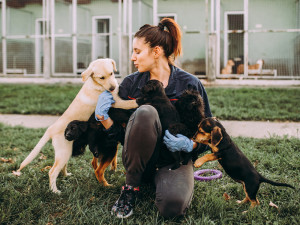6 Things to Know Before Fostering a Cat
Ready to make a difference in a kitten’s life?

Share Article
Spring marks the start of kitten season, though rescue workers have reported the season now lasts for much of the year, and shelters are feeling the strain. That’s where you come in. If you’ve ever considered fostering a cat, now’s the time. But while the decision to foster might seem like a no-brainer (who doesn’t want to be surrounded by as many purring, adorable creatures as possible?), it’s a big responsibility, and there are a few important steps to take first.
1. Find your why.
While euthanasia of homeless animals is dropping significantly every year, there are far more cats who are unable to find a home than dogs. Neonatal kittens are some of the most vulnerable homeless animals, and shelters can be extremely stressful for cats, causing them to get sick with upper respiratory infections. When appropriate housing for cats in a shelter is combined with lots of enrichment, it can help prevent cats from getting sick, but there is no better place for a cat to wait for a new home than in a foster home.
Maybe your “why” is to help reduce euthanasia of cats in shelters, or maybe it’s to help make their transition to a new home as stress-free as possible. Maybe you want some companionship or to learn more about the stages of kitten development by raising a litter. Regardless of your motivation, it’s important to be committed to giving your fostered animal the best experience possible.
2. Attend any required trainings and talk to someone who’s done it.
Your local shelter or rescue will likely have a process to become a foster parent which might include an application about why you’re interested in the program, an orientation to learn more about the organization and their policies, and introductions to staff or volunteers who will be able to help you. Some questions to ask:

Is the organization able to provide you with some or all of the supplies you’ll need, or should you be prepared to spend a little money? Most organizations will give you the basics – food, litter, bowls, toys, bed – but if you’re like me, you’ll end up buying kitten tunnels and interactive toys while stacking the latest cute cat bed on top of a cute cat bed.
What is the organization’s emergency protocol if you have a question or urgent issue late at night? Most likely, you’ll be given a phone number of someone on call to guide you through the situation.
What are the organization’s medical protocols? Any foster cat or kitten should come to you vaccinated with age-appropriate vaccines (rabies, distemper, and any others recommended by a veterinarian). If kittens are too young, an appointment should be made so they can receive vaccines during their stay with you. They should also be treated for any internal and external parasites like roundworms and fleas.
Lastly, ask about the adoption process. Will you be part of helping to find a new home (if you want to) or will the shelter handle the adoption process?
3. Make sure everyone is on board.
Check with your roommate, partner, children, or your senior dog to make sure everyone is excited to foster and then divvy up the duties. Who will be the point person for the shelter and who will make sure that the kittens are eating enough, using the litter box, and not showing signs of sickness? Who gets to scoop the litter box each day (or more than once a day if you’re working with multiple cats or kittens)? Who is Head of Playtime? Raising a litter of kittens can be a wonderful experience when everyone is all in.
4. Prepare the space.
You don’t need an 800-square-foot finished basement to foster kittens. Many people use a bathroom, guest room, or home office. There should be enough space that a litter box is not directly near their food and water, and enough room to play. If you’re short on space, you can create vertical options for kittens to climb up on cat trees or install walkways along the wall. The most important thing is that the room be cleanable. Carpeting or lots of heavy furniture make disinfecting difficult between cats, which is critical if you’re planning to foster more than once (and we hope you are!).
Good ventilation and temperatures that aren’t too hot or too cold are important to keep cats and kittens healthy. If you’re planning to give your foster cat access to your entire home (and the shelter is OK with this!), it’s still a good idea to give them a safe room for the first few weeks to help them acclimate and to watch for any signs of sickness.
5. Prepare any resident pets.
If you already have a pet of your own, remember that most foster kittens can’t be mixed with your pets, at least for the first month or longer in the event they’re carrying a disease that can be transmitted to your resident pets (particularly other cats). Tests for certain diseases are not always an option or accurate until kittens reach a certain age, so it’s better to be on the safe side. Your local shelter or rescue will provide you with any medical information and instructions before you take a litter of kittens or a cat home. Assuming you’re providing temporary care to a healthy cat and the shelter thinks they may benefit from getting to know your dog, be sure to do a slow introduction to keep everyone safe.
Learning about a foster cat’s preferences for living with another animal (or not) is key to finding a loving adoptive home down the road, and the shelter can help you find a balance between protecting everyone from any potential diseases while also letting them experience life in a home.
6. Prepare to say goodbye.
This is the part most people dread, but it gets easier with time – we promise! The first litter or adult cat is always the hardest. You can’t imagine that anyone could possibly care for them as well as you can. While it’s 100 percent okay to adopt a foster animal, remember that every time you keep one, it impacts your ability to foster again.
If you don’t have any pets of your own, you can choose to take on cats recovering from an illness without worrying about making your own pet sick and you won’t have to worry about resident and foster animals getting along. Whatever you decide, pat yourself on the back for saving a life.

Lindsay Hamrick, CPDT-KA
Lindsay Hamrick lives in New Hampshire with her three dogs, chickens, and an assortment of rotating foster animals. She forces her elderly chihuahua, Grandma Baguette, on overnight backpacking trips, can diaper a lamb with one hand, and while she’s a long-time Certified Professional Dog Trainer, 66.7% of her dogs still won’t lay down when asked.
Related articles
![anonymous woman pampering and taking care about a small ginger kitten]()
6 Ways to Help Local Shelters Without Committing to Full-Time Pet Parenthood
Learn how you can be there for animals in need this National Pet Day.
![Woman holding dogs at an animal shelter]()
10 Ways Animal Shelters Are Upping Their Game
New trends we can totally get behind.
![A hand holding a kitten with a cat tattooed at the hand.]()
Heads Up: It’s Officially “Kitten Season”
Hannah Shaw, aka Kitten Lady, on how you can care for orphaned kittens this spring.
![The Wildest's cover star Hannah Shaw smiling at the camera behind a cat tower with two kittens sitting on top of it]()
“Kitten Lady” Hannah Shaw Is Fostering a Movement
The lion-hearted animal advocate on rescuing her first kitten in a tree, designing an orphaned animal nursery, and becoming an Instagram sensation.




